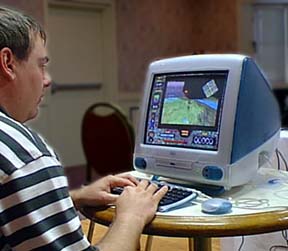 This is not like any other computer, being
well ahead of its time. Within just over a month from its release, its operating
system Mac OS 8.1 will be upgraded to Mac OS 8.5 and the newer system
will increase this computer's performance by 30%.
This is not like any other computer, being
well ahead of its time. Within just over a month from its release, its operating
system Mac OS 8.1 will be upgraded to Mac OS 8.5 and the newer system
will increase this computer's performance by 30%.The by this time next year, the new OS X will be available increasing its performance several times more. Most computers when they are sold are already obsolete, especially low priced ones, but this computer is state of the art and will only continue to improve with the addition of newer software systems to come in the future.
The original Mac was released in 1984 and can still be used today doing the job it was intended to do. We expect this computer to perform in a similar manner, year after year offering the user high performance, ease of use and continued functionality as new technologies become available.
And for those who just want to play around, the accelerated graphics provide amazing imagery with chest thumping sound effects. And for those who already have a bunch of favourite software, Macintosh, Windows 3.1, Windows 95, DOS, this computer can play them with astonishing ease, using simple software to fill the compatibility gap.
Though these pictures reveal it as a small computer it has a full size 15" monitor and house it and its mother board in a package smaller then most monitor cases.
At $1,999 this computer will replace or be a superior addition to what ever computer system you have at home, at work or at school ready to run as a network or connected to the Internet without any parts to buy or install. But when you do want to buy some additional equipment like a printer, camera or scanner you simply plug them in and they work, not installation routines and no "config" files to run.
The machine comes standard with 32MB of memory and a 4GB hard drive, 24xCD, 56K modem, 2MB of video RAM, ethernet connection and the ability to interact with laptops and hand held units using infrared communications. Built of bullet proof plastics the machine is a full 39 pounds. The computer's central processor the third generation PowerPC Motorola chip uses a measly 4.5V of electricity generating little heat and running as a RISC processor at 233MHZ. Though the 233MHZ sounds like it should be slower then a 300Mhz Pentium II the G3 750 processor uses backside caching to produce astonishing smooth performance doing measured tasks twice as fast as the Pentium II 300 processor.